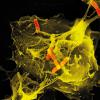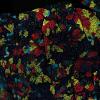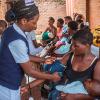Biomedical Scientist Carl Onwochei on why we need to stay informed, challenge misinformation and be open to discussion.

Forty-two years after the first case of HIV/AIDS was confirmed in the UK, there is still widespread discrimination and misinformation regarding the condition, according to research conducted by the National AIDS trust.
Arguably, the vast majority of perceptions surrounding HIV stem from early, poorly executed public health campaigns that spread fear within local communities – remember the “Don’t die of ignorance” advertisement with the tombstone? It was successful in creating the fear of people with HIV, the remnants of which unfortunately remain in 2023.
However, there has been some progress made to inform and educate the public about HIV – not just the disease process, but the complex biopsychosocial interactions that make HIV unique for every person living with the condition through groundbreaking programmes such as the documentary HIV and Me by Stephen Fry and the popular Channel 4 series It’s a Sin, written by Russell T Davies.
Antiretroviral medication
In 2019, there were approximately 107,000 people living with The human immunodeficiency virus (HIV) in the United Kingdom.
In the 80s it was assumed that HIV was a gay disease, but the demographic of people affected by the condition is varied. People from all backgrounds and walks of life live with HIV, however, there are certain groups that are disproportionately affected – gay and bisexual men, migrants, people from black African and Caribbean ethnic communities, and intravenous drug users.
Today, HIV can be managed effectively with antiretroviral therapy (ART) and regular check-ups. This means that people living with HIV, diagnosed and treated at an early stage, have a normal life expectancy. Being on effective treatment also means that people cannot pass the virus on to others. In spite of the medical advances that address the medical management of HIV, the psychological and social aspects of the condition still have deleterious effects on individuals.
“As biomedical scientists, we can foster inclusivity and mindfulness by treating high-risk samples with dignity”
Knowledge and attitudes
As a biomedical scientist working in infection science, and an HIV-positive person, it is important to acknowledge that society’s knowledge and attitudes have not kept up with medical advancements. Unfortunately, there are still widespread misconceptions surrounding HIV, and these negative attitudes can lead to the unjust treatment of individuals living with HIV.
Stigma can arise from various factors, including misinformation about HIV transmission and the association of HIV with health behaviours and lifestyles that some may disapprove of. Moreover, when HIV intersects with other aspects of our lives, such as sexuality, gender, ethnicity and nationality, it can further exacerbate the negative attitudes individuals face and even impact their self-perception.
To effectively tackle the consequences of this condition from a perspective of equality and diversity, it is crucial to consider the intersectionality of HIV. Consequently, the lived experiences of individuals with HIV can vary significantly. Intersectionality aims to address the overlapping discrimination that some people with HIV may encounter, which can ultimately have adverse effects on their mental and emotional well-being.
As biomedical scientists, we can foster inclusivity and mindfulness by treating high-risk samples with dignity, by not making assumptions about an individual’s lifestyle and by being an ally to those living with and affected by HIV. It can be easy to forget that behind vials of blood, there are individuals whose lives are about to be changed immeasurably.
Prevailing attitudes
The landscape of HIV has undergone significant transformations, yielding positive outcomes for those affected. However, there remains a considerable distance to cover in terms of addressing the prevailing attitudes and comprehension surrounding the experience of living with HIV. HIV does not exclusively manifest in one demographic. It can affect individuals across wider society.
The World AIDS Day survey, conducted by the Terrence Higgins Trust in 2022, found that 74% of HIV-positive people have been subjected to stigma and discrimination because of their status. One third experienced discrimination from friends and family, and one third experienced discrimination within the workplace. By staying informed and challenging misinformation, being open to discussion and learning, and using supportive language, we can all contribute to ending HIV and the stigma.
Carl Onwochei is a Biomedical Scientist at Public Health Wales NHS Trust.
Image credit | SPhotoL




